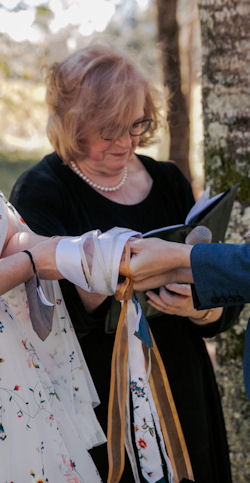Handfasting vs Handtying
vs Tying the Knot
Categories: | Wedding Ceremony | Wedding Rituals |
 Is there a difference between a handfasting
and a handtying as a wedding ritual? I believe
there is. But it is not what you think it is!
Is there a difference between a handfasting
and a handtying as a wedding ritual? I believe
there is. But it is not what you think it is!Should celebrants who include a handfasting ritual within a marriage ceremony be calling it a handtying? Should we be reserving handfasting for the full-on pagan ceremony?
While that's a matter for quite lively discussion in UK celebrant circles, historically, there are no grounds for such a dichotomy, or for suggesting that referring to the ritual within a civil marriage ceremony (or non-legal wedding) as a handfasting is somehow wrong! Indeed, the Oxford English Dictionary defines Handfast as "To make a contract of marriage between (parties) by joining of hands."
I've been including handfasting rituals in civil ceremonies for over 15 years and have also carried out full handfasting ceremonies, so here is my take on the handfasting/handtying controversy.
Handfasting
A non-spiritual Handfasting ritual as we know it today has its origins in what was legally Marriage by Consent, (where all that was required for a legal marriage was that the couple declared their intention to live together as husband and wife in front of witnesses) was legally recognised in most of Europe until the early 16th century (the Reformation). In Scotland, however, such 'írregular' marriages continued to be legally recognised right up until the Marriage (Scotland) Act of 1939. Before 1939 handfastings which took place instead of a church wedding were legally recognised as marriage by declaration, a wedding that resulted in marriage. Even after 1939 marriage 'by cohabitation with habit and repute' was legally recognised until 2006.
In Australia, technically, you, the marrying couple marries yourselves by making a verbal declaration in front of witnesses. Once you have done that, you are legally married. Of course, there are other legal prerequisites, including paperwork, and the presence of an authorised celebrant, but the actual moment of marrying is carried out by the couple themselves.
Handfasting is a term that immediately alerts us to three things
- it is a couple thing in which two people's hands
are joined together
- it is a visual expression of a commitment to an ongoing relationship between the couple
- it is an active action and a willing choice
Pagan handfasting vs
handfasting ritual
Civil weddings "in the round", only work for guests and the photographer, when you have a small number of guests and when the wedding party, including the celebrant, are part of the circle rather than in the middle of it.
The pagan inclusions of the elements of earth, air, fire and water are, to this day, included in both church ceremonies and secular civil weddings.
- Earth represented by gifts (and in church by the collection plate/offerings)
- Air represented by the vows (and in church by incense)
- Fire represented by candles, including the very popular Unity Candle
- Water represented by various Wine Ceremonies
and/or the sharing of wine or other beverage
Handtying
Tying the knot
While handfasting is often explained as the origin of the term "tying the knot" meaning to get married, tying the knot as a ritual within a ceremony usually involves the couple tying a knot in one piece of rope, or tying two pieces of rope/cord together, without their hands being tied together. There are numbers of ways to incorporate knot-tying as a ritual in a marriage ceremony. All of them lovely, all of them actively involving the couple, all of them photogenic, but none of them a good fit with the term handfasting.
Does it really matter?

workQueen